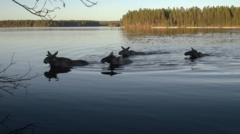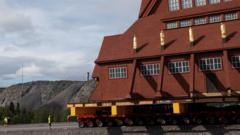Every spring, an extraordinary event captivates millions: "The Great Moose Migration," a round-the-clock livestream that follows the journey of moose across northern Sweden. This live broadcast, now in its sixth year, allows viewers to witness the animals as they swim across the Angerman River in search of summer pastures. This year's livestream, managed by Sweden's national broadcaster SVT Play, commenced a week earlier than anticipated due to the unseasonably warm weather.
Since its inception in 2019, the broadcast has transitioned into a "slow TV" phenomenon, garnering a dedicated following. For instance, Cait Borjesson, a viewer who discovered the livestream during the height of the Covid-19 pandemic, expressed her deep connection to the show, stating that she has kept her television on for 16 consecutive hours since the stream began. For many, this serene display of nature functions as a form of therapy, helping with anxiety and offering a soothing escape.
The livestream isn't just a solitary experience; a Facebook community has emerged, exceeding 77,000 members, united by their admiration for the migration and the shared moments they encounter along the way. The journey of the moose notably travels through the village of Kullberg, where they follow historical migratory routes that have persisted since the ice age.
Goran Ericsson, a dean at the Swedish University of Agricultural Sciences, pointed out that approximately 95% of northern Sweden's moose undertake this migration each year, seeking warmer weather and greener pastures. Insights from researchers like Minh-Xuan Truong emphasize the audience's preference for experiencing the raw sounds of nature, without distractions such as music or commentary, as they enjoy the slow-paced unfolding of the natural world.
Sweden is home to around 300,000 moose, and these inhabitants are often affectionately referred to as the "King of the Forest," underscoring their significance in Swedish culture. The live stream highlights this relationship, resonating with audiences and providing a window into the wilderness that many find healing and inspiring. The recent increase in viewership, with nearly nine million tuning in during 2024, illustrates the public's enduring fascination with nature in an ever-accelerating media landscape.



















